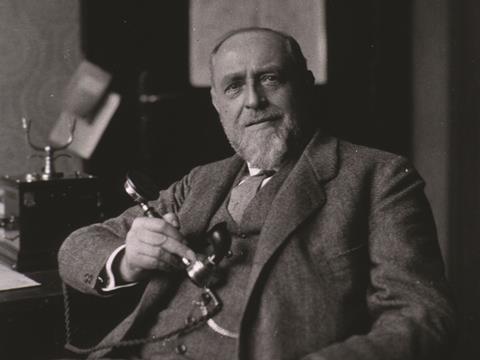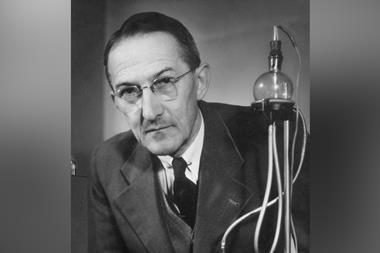The kit that brought pH measurement into reality
German physiologist (1865–1935). Inventor of the glass electrode
The process of learning about the world involves building simple mental pictures we can use to gain knowledge. Yet deepening our understanding invariably involves having to unlearn some ideas so deeply embedded as to become almost intuitive. At the very least, we are forced to let go of some of those certainties as we start to appreciate the complexity of our world. The story of the glass electrode is a curious tale of learning and unlearning.

In the early 18th century, electrical materials were divided into two broad classes by the English astronomer Stephen Gray: conductors and insulators. But almost as soon as the Leyden jar was invented, the Dutch physicist Pieter van Musschenbroek noticed that not all jars were alike. While some could be made to deliver whopping charges, others either failed to do so or simply lost their charge with time. Van Musschenbroek speculated that perhaps the glass could conduct electricity; the British scientist Henry Cavendish later showed that Leyden jars lost their charge spontaneously when heated.
In the early 18th century, electrical materials were divided into two broad classes by the English astronomer Stephen Gray: conductors and insulators. But almost as soon as the Leyden jar was invented (Chemistry World, April 2017, p70), the Dutch physicist Pieter van Musschenbroek noticed that not all jars were alike. While some could be made to deliver whopping charges, others either failed to do so or simply lost their charge with time. Van Musschenbroek speculated that perhaps the glass could conduct electricity; the British scientist Henry Cavendish later showed that Leyden jars lost their charge spontaneously when heated.
The conductivity of glass was finally demonstrated systematically in 1854 by the German physicist Johann Heinrich Buff, a man whose connections extend into being related, by marriage, to both chemists August Hofmann and Justus Liebig. Buff, who had measured electrical conductions in gases and plasmas, extended his studies to glass across a range of temperatures and put paid to the idea that it was one of the best insulators. His work also attracted others into the field. William Thompson (later Lord Kelvin) was able to make a battery in which a thin sheet of flint glass separated two half-cells. Almost at the same time Wilhelm von Beetz observed that certain types of glass weren’t just significant conductors of electricity, but conduction led to changes in alkalinity at the oppositely polarised surfaces.

It was one of the assistants of the brilliant polymath scientist Hermann von Helmholtz, Wilhelm Giese, who made a critical set of measurements while doing research for his doctorate in 1878. Giese was interested in trying to understand the nature of the charges in a Leyden jar, and suspected that it was related to surface charges on the glass. He built a thin-walled evacuated, mercury-filled tube equipped with an electrode, then sealed this inside a second tube, also equipped with a platinum wire but filled an aqueous solution. Giese found that a voltage developed between the electrodes. This potential depended on the nature of the aqueous solution, while the rate at which the voltage was established depended on the thickness of the glass – thin glass responded much faster.
The work may well have influenced his boss, who spoke at a Faraday discussion meeting in London in 1881. There, Helmholtz argued that electrochemistry could only be understood in terms of charged particles. He reported a cell similar to Giese’s, but with the mercury replaced by copper sulphate and the other solution with zinc sulphate. This behaved exactly like a Daniell cell (Chemistry World, November 2014, p37) showing that the glass acted like a highly resistive electrolyte. Surprisingly neither Helmholtz nor Giese (then the head of the German Polar research station on Baffin Island, Canada) recognised the potential of their observations, even as Wilhelm Ostwald and Svante Arrhenius established the reality of ions in electrolytes and of the dissociation of acids and alkalis.
The work may well have influenced his boss, who spoke at a Faraday discussion meeting in London in 1881. There, Helmholtz argued that electrochemistry could only be understood in terms of charged particles. He reported a cell similar to Giese’s, but with the mercury replaced by copper sulphate and the other solution with zinc sulphate. This behaved exactly like a Daniell cell showing that the glass acted like a highly resistive electrolyte. Surprisingly neither Helmholtz nor Giese (then the head of the German Polar research station on Baffin Island, Canada) recognised the potential of their observations, even as Wilhelm Ostwald and Svante Arrhenius established the reality of ions in electrolytes and of the dissociation of acids and alkalis.
A physiologist hit the jackpot 25 years later. Max Cremer was born in Ürdingen, on the banks of the Rhine in the Ruhr, the industrial heartland of Germany. He studied medicine in Bonn, Würzburg and Berlin, but rather than go into practice he pursued an interest in physiology and continued his studies. Unusually, however, he focused on physics and mathematics, then an unlikely combination for one interested in biology. He obtained his habilitation at the Institute of Physiology in Munich, having studied with the great physiologist Carl von Voit and the chemist Franz von Soxhlet (Chemistry World, September 2007, p77). Here, Cremer studied the metabolism of carbohydrates, establishing the relationship between glucose and glycogen and unravelling the biochemical pathways of the livers of rabbits.
A physiologist hit the jackpot 25 years later. Max Cremer was born in Ürdingen, on the banks of the Rhine in the Ruhr, the industrial heartland of Germany. He studied medicine in Bonn, Würzburg and Berlin, but rather than go into practice he pursued an interest in physiology and continued his studies. Unusually, however, he focused on physics and mathematics, then an unlikely combination for one interested in biology. He obtained his habilitation at the Institute of Physiology in Munich, having studied with the great physiologist Carl von Voit and the chemist Franz von Soxhlet. Here, Cremer studied the metabolism of carbohydrates, establishing the relationship between glucose and glycogen and unravelling the biochemical pathways of the livers of rabbits.
As his independent career blossomed, Cremer’s interest in biophysics came to the fore. He wanted to understand the role of cell membranes. Aware of the Helmholtz and Giese’s work, he reasoned that gossamer-thin glass might be a good analogue. Taking a glass tube, he blew a small, thin bubble at one end. With a platinum wire and a standard solution inside, he placed his bubble tube into a second solution. The electromotive force across the glass bubble varied as he changed the degree of alkalinity and acidity of the solution. It was the birth of what we now call the glass electrode, though the application never occurred to Cremer.
In 1909, the same year that Sørensen proposed the pH scale, Fritz Haber (Chemistry World, July 2012, p62) and his student Zygmunt Klemensiewicz conducted an acid-base titration using a variant of Cremer’s bulbous electrode. This demonstrated that the potential depended on the logarithm of the proton activity. The glass electrode was now a real instrument – the first ion-selective electrode – that could be used to measure Sørensen’s pH with ease, and spread rapidly across wide areas of science.
In 1909, the same year that Sørensen proposed the pH scale, Fritz Haber and his student Zygmunt Klemensiewicz conducted an acid-base titration using a variant of Cremer’s bulbous electrode. This demonstrated that the potential depended on the logarithm of the proton activity. The glass electrode was now a real instrument – the first ion-selective electrode – that could be used to measure Sørensen’s pH with ease, and spread rapidly across wide areas of science.
The result is that the concept of pH has become one of those simple ideas embedded deep within the psyche of anyone who has studied science. And yet, if you ever find yourself having to teach about pH it’s important to remind yourself that an idea that simple, surely, must be too good to be true. Do you dare to dig a little deeper?
References
1 M Cremer, Z. Biologie, 1906, 47, 562
2 F Haber and Z Klemensiewicz, Z. Phys. Chem., 1909, 67, 385












No comments yet